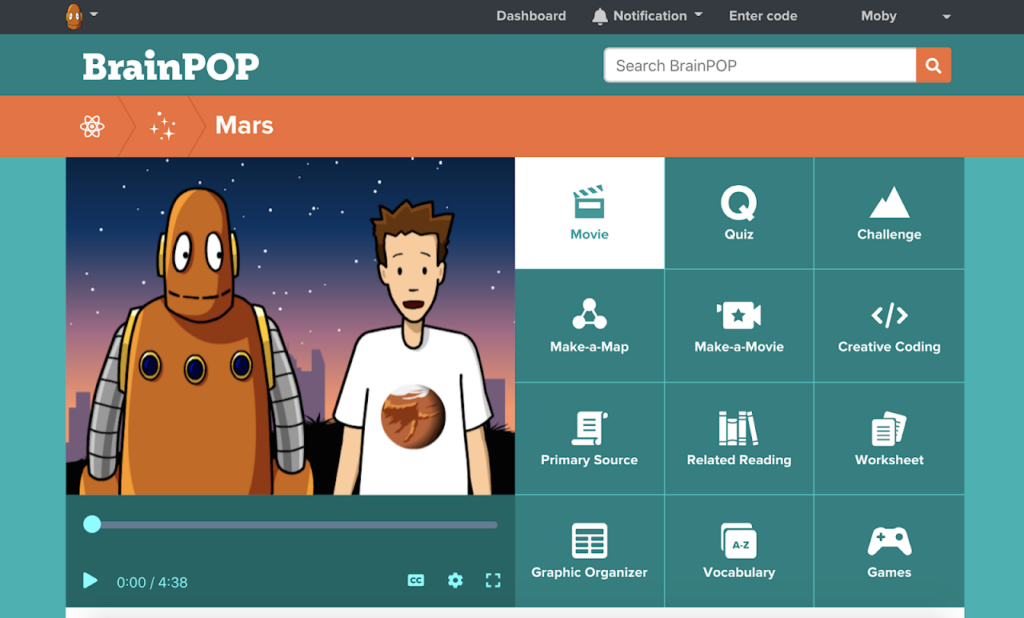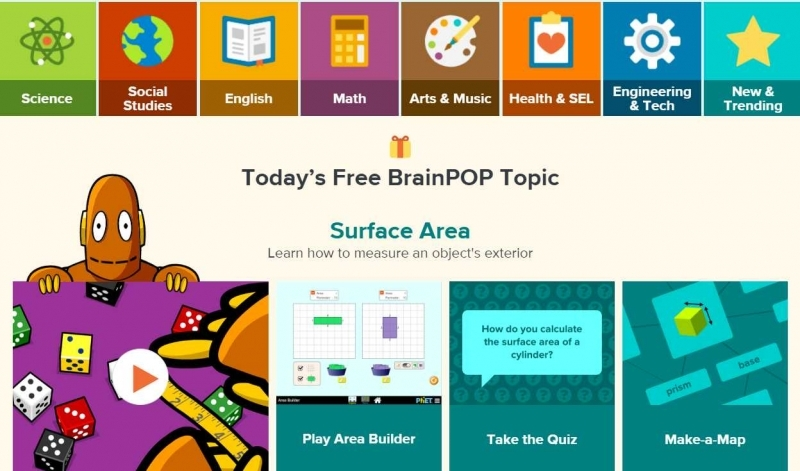BrainPOP is online homeschool educational online app. They provide online classes that you may access at any time and from any location for grades kindergarten through eighth. The fact that Brainpop jr login offers more than just academic disciplines like math and reading is one of the things that draws people in.
They also teach social studies, science, engineering, health, music, and the arts, as well as technology! Because of this, BrainPOP is a fantastic choice for children with a wide range of interests. Brainpop jr login is also well-known for its quick, animated films that provide topics in an entertaining and interesting manner. Interactive games, quizzes, and tasks are presented after these films to further reinforce the lesson.
What is BrainPOP?
BrainPOP is primarily a website that hosts videos and produces original educational content. Because the same two personalities host all of the videos, the content is consistent, and the students are made to feel more at ease. Although the films cover a wide range of topics, their main goal is to simplify difficult concepts so that they are readily comprehended. Basic subjects like math and English are covered, as well as more difficult subjects like politics, geometry, and genetics. BrainPOP offers students CASEL model content in addition to other subjects like engineering and health. It also includes social-emotional learning.

How does BrainPOP work?
Since BrainPOP is web-based, any browser can access it. As a result, most devices that have a strong enough internet connection to stream cartoon videos will be able to use this. Teachers can share videos with the class after registering. However, students’ access on their own devices is also possible. Because of this, brainpop jr login may be applied outside of the classroom. The films might be a bit of an overview in most circumstances, but there are a few follow-up elements that serve to enhance the learning impact.
There are sections where students may read more about a particular topic; they can also continue with quiz-based evaluations and other learning activities. In order to better continue teaching or suggest new videos, teachers may monitor student involvement and progress. While this is a terrific approach to introducing students to video-based learning, it is usually best used as a preface to a topic before more in-depth instruction takes place in the classroom.
Which BrainPOP features are best?

The website mostly consists of BrainPOP videos, which are what give it its usefulness as a resource—they include entertaining and captivating unique information. But there’s also value in the instruments utilized for evaluation and additional learning. Using multiple-choice questions and answers, the quiz part allows students to put what they’ve learned into practice. Students may utilize the idea of map-style output created by combining text and images in the Make-A-Map section to plan, edit, arrange, and more.
Even better, students may make their own videos with the Make-A-Movie tool, which accomplishes exactly what its name implies by providing a simple video editor. Everything is shared, so this might be a good approach to accumulating valuable material for later use. In a portion where students may code and create, coding is also covered. In addition to producing a useful final product, this aids students in learning and practicing coding.
Students get the option to apply what they’ve learned to the assignments by playing the games that are accessible. Sortify and Time Zone X are two instances of games that blend enjoyment and difficulty to assess students’ grasp of the material.
What is the price of BrainPOP?

BrainPOP website has a two-week trial period before it is charged. Plans are available for families, homeschoolers, schools, and districts. Brainpop jr login offers three alternatives for homeschooling.
- Grades 3–8: BrainPOP Homeschool, $39.95 per month
- For $29.95 a month, BrainPOP Homeschool Jr. (Grades K–3)
- Grades K–8 BrainPOP Homeschool Combo: $49.95 per month
Before you buy, BrainPOP provides a free two-week trial. You may use the free trial to see if BrainPOP is a good fit for your family because it provides access to all of the benefits of the premium membership.
BrainPOP best Tips and Tricks
- Check the class: Assign a video and have the class read the extra information and content, then carry out a quiz to see how well each student can uptake the information in the time given.
- Map it out: Have students use the Make-A-Map tool to plan a project before they start, turning in the plan as part of the assignment process.
- Present in video: Have a different student, or group, present back on a topic covered each week by making a video using the BrainPOP video maker.
What comes with the purchase?

You will receive a BrainPOP online subscription with your purchase. As soon as you register, you will be able to form classes, assign lessons, and monitor the work that your students turn in. Additionally, you will gain access to BrainPOP Educators, a website dedicated to providing teachers with extra materials, including lesson plans and standard alignments. You may create accounts for each of your students after setting up your parent account and the classes for your students (I’ll go into more depth on how to accomplish that later in the review). After they log in, your students will have access to every lesson you assign them.
Top 12 Best Brainpop Alternatives in 2023
Checkout top 12 best Best Brainpop Alternatives educational apps in 2023.
1. Science Buddies
The greatest buddy for every science teacher is this website. It is jam-packed with free experiments, lesson plans, and videos that you can search by subject and grade level. With a plethora of scientific method materials, science fair preparation tools, and a massive archive of project ideas, this is also a fantastic resource to have during science fair season. Additional tests and quizzes are available when you utilize Science Buddies with Google Classroom.
Try it: Science Buddies
2. Wakelet
Consider Wakelet as a cooperative information-sharing and organization tool. Utilize it to develop and distribute lessons to your students by gathering resources in one location and adding your own annotations and explanations. Better still, let students use it directly in Google Classroom to generate newsletters, book reports, presentations, and more.
Try it: Wakelet
3. Boddle Learning
Students may tailor their learning through enjoyable game play that is completely in line with state standards using Boddle, a super-engaging math platform for grades K–6 (they just released ELA material!). Instructors are able to personalize assignments and assign them directly from within Google Classrooms. Although there is a premium edition of Boddle, its resources are free.
Try it: Boddle
4. Flocabulary
Instead of interacting with top-notch instructional material, your students—and most likely your teacher neighbors—will believe they are at a concert when using Flocabulary. You can take a free 30-day trial right now. It offers materials for a wide range of disciplines and is appropriate for grades K–12. Instructors may use Google Classroom integration to create and assign tasks for individuals or full groups.
Try it: Flocabulary
5. Legends of Learning
When you use Legends of Learning to assign math and science coursework, K–8 teachers will feel like superheroes. Students can use engaging and entertaining games and simulations to practice the concepts they are learning in class. Are you looking for more interesting methods to help your students learn their math facts? Math Basecamp is a fact-mastery practice game that Legends of Learning just released.
Try it: Legends of Learning
7. WeVideo
WeVideo offers your students an imaginative and distinctive approach to showing that they have understood a unit of study. Additionally, it exposes students to the multi-media realm of editing and producing videos. With the current version of WeVideo, students may record a video and turn it in with any assignment using the Google Classroom add-on. Take a look at these fantastic WeVideo project ideas for your students.
Try it: WeVideo
8. Desmos
Math teachers in middle schools are needed! Free and fully customizable question sets from Desmos fit your requirements and work well with your Google Classroom stream. With interactive tools and virtual manipulatives, your students will be mastering challenging math topics while thinking critically.
Try it: Desmos
9. Duolingo
With entertaining and customizable tasks that can be sent directly to your Google Classroom, this 100% free tool assists students in learning a new language and is aligned with both the ACTFL and CEFR standards. Because of how enjoyable the gamification element is, students tend to forget that they are truly learning!
Try it: Duolingo
10. Newsela
Teachers may select from hundreds of thousands of articles on Newsela to go along with their teaching. Using Google Classroom, teachers may give their students a single text or a group of texts. Newsela is a fantastic teaching tool since it covers a wide range of topics, from science and SEL to social studies and current affairs. These pointers can help you use Newsela in any kind of classroom.
Try it: Newsela
11. Pear Deck
Pear Deck adapts education to match the requirements of students by utilizing tried-and-true formative assessment methodologies. Its vast library of interactive courses enables professors to instruct whole classes or let students work at their own speed, making it ideal for online learning. With the Google Classroom add-on, Pear Deck Premium customers can easily include their Pear Deck lessons.
Try it: Pear Deck
12. Tynker
With Tynker, students may learn the fundamentals of coding through interactive software that also helps them move on to learning Python and JavaScript. With hundreds of lessons and over 70 courses, the application is completely linked with Google Classroom.
Try it: Tynker

